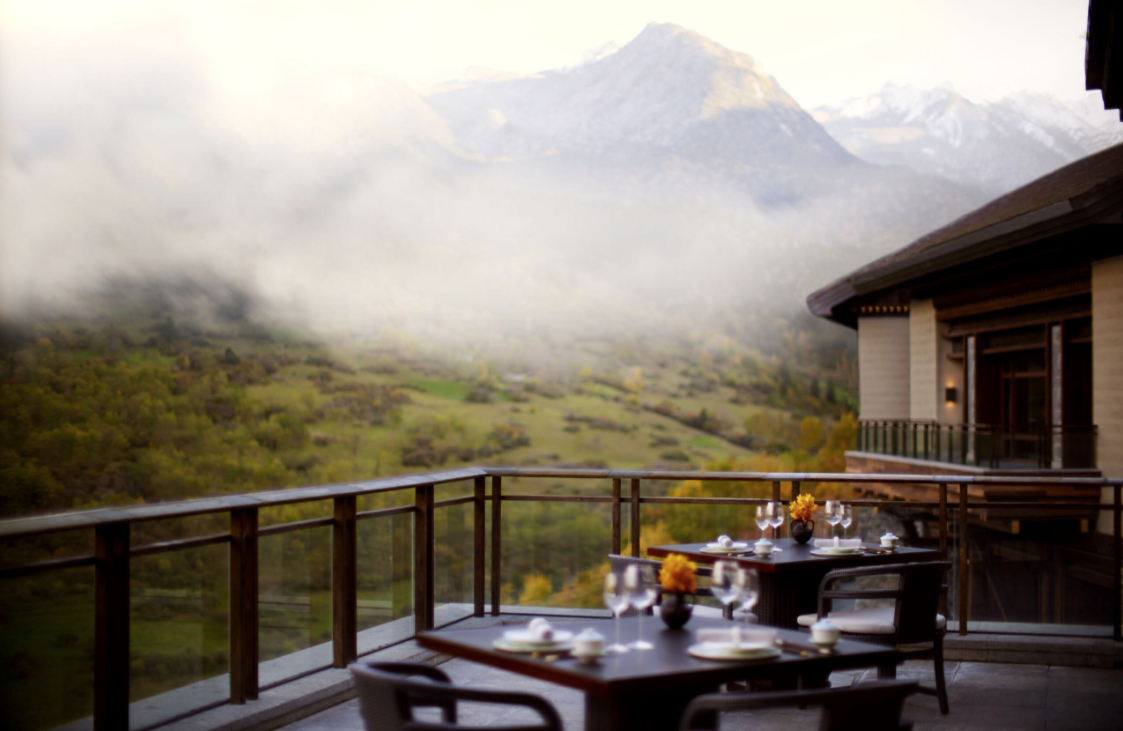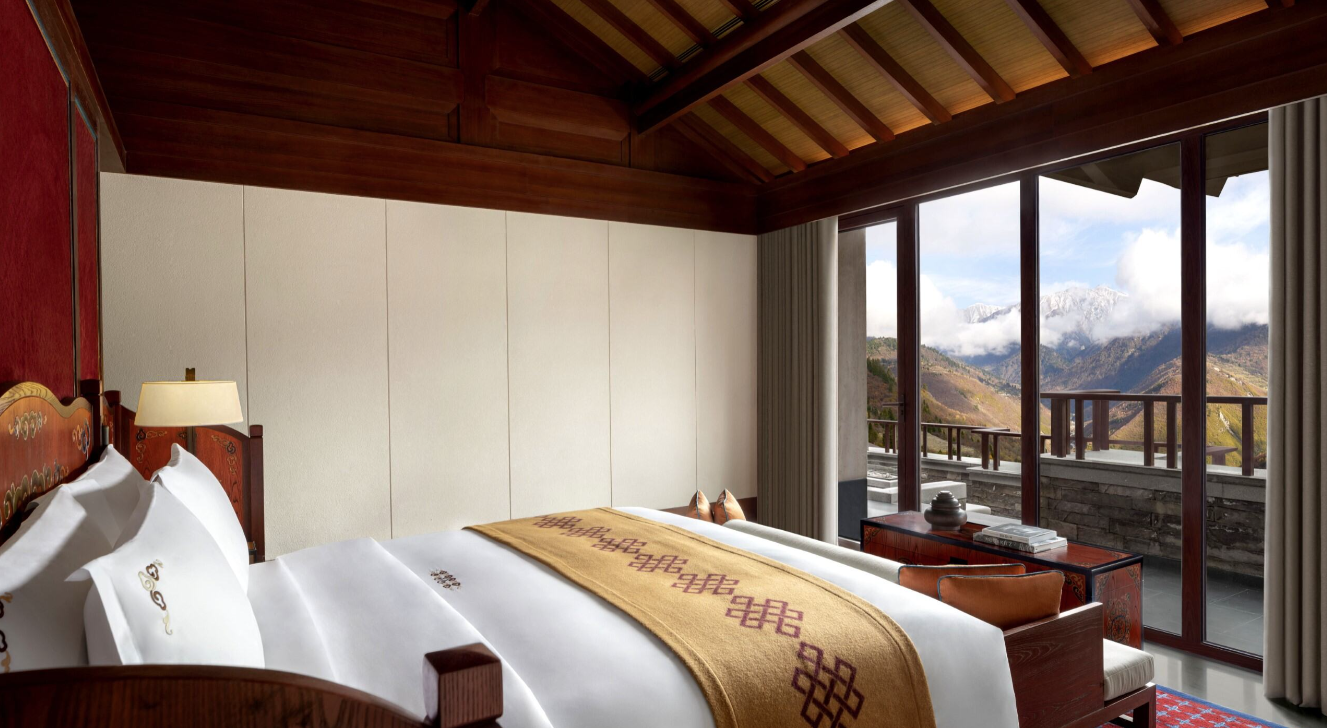The first Ritz-Carlton Reserve in China, the all-villa Rissai Valley brings luxury to a UNESCO World Heritage Site and Biosphere Reserve. It’s no easy feat to reach it. But once you’ve arrived and settled into the gentle rhythms of the place, leaving, Stephenie Gee discovers, is no easy feat either

Tibetan legend has it that long ago, Earth was once a hostile and inhospitable place, riddled with drought and denuded of greenery. Saddened by the sight, the young god Dage and beautiful goddess Semo decided to breathe life into it. Mountains rose, rivers flowed, forests flourished and creatures of all shapes and sizes began to roam. The two fell in love, and as a token of affection, Dage presented Semo a divine mirror made from the heavens. But the devil, jealous of their union, intervened, and the mirror slipped through her fingers into the valley below, shattering into the 108 sparkling, gem-like lakes of Jiuzhaigou.
A local tells me this at a service station we’ve stopped by on our way to Rissai Valley, a Ritz-Carlton Reserve. The first Reserve – the analogy is to winemaking, which is to say that the Reserves are the most extravagant hotels in the Ritz-Carlton collection – in China and the latest to join the portfolio of only six worldwide, this magnificent rare estate is nestled amid the enchanting landscapes of Jiuzhaigou (translating to “Nine Village Valley” in reference to the nine villages that once occupied the area) on the Tibetan Plateau in China’s southwestern Sichuan province. Getting there is arduous. From Chengdu, domestic flights to the Jiuzhai Huanglong Airport are limited and run only once a day, so instead we catch the 90-minute train to Zhenjiangguan station from where it takes another three- hour (two-hour if from the airport) drive to the hotel. But it’s worth the effort, our driver assures us – it is said that if paradise exists on Earth, it is here.

From the hotel gates at the foot of the mountain, it takes another near 15 minutes before our car pulls up to the main building. Five or six staffers dressed in traditional Tibetan attire already stand waiting, bearing golden khatas, a traditional ceremonial scarf in Tibetan Buddhism symbolising blessings and good wishes, that they drape around our necks. Once inside, you immediately pick up on the design mandate led by the late Jaya Ibrahim, whose works are characterised by balanced symmetry and pared-down luxury. The lobby is anchored by natural light, which floods in through expansive windows aligned with the snowy peaks at the end of the valley, casting a warm glow on the rich wooden architecture. Scented towels, warm tea and a traditional folk dance complete the welcome ritual before our butler, or nieba in the local language, escorts us via buggy to our villa for check-in.
There are 87, each offering panoramas of the valley and decorated in woods and earthy tones that defer to the brilliance outside. Local touches are woven throughout like red and yellow (sacred colours in the culture) accents, yak (long-haired cattle indigenous to the area) wool rugs, and embroidery by the local Qiang ethnic group. Spanning 1,700 square feet, our Deluxe Reserve Villa comes with the works – a private courtyard, fully-equipped kitchen, dining room, living room, bedroom suite, stone-clad bathroom complete with double basins, a deep soaking tub and three rainforest showers, and a spacious patio with a fire pit and telescope. For day one, we are under instructions to do nothing but acclimatise. Rest, breathe, nibble on chocolate and drink lots of fluids, our nieba tells us. Rissai Valley sits at 2,300 metres above sea level, and that’s a low point in the Jiuzhaigou landscape. We do as instructed, cracking open the complimentary minibar, before deciding to venture out on the grounds.

The sense of place here is pervasive. Derived from the Tibetan word for “village”, Rissai Valley effortlessly weaves into the surroundings, modelled on a traditional local village with the main complex arranged in an endless Tibetan knot, signifying rebirth, so guests can emerge feeling recharged. Made of local schist stones, the dry-stack stone walls that line the path recall mani stones (stones carved with mantra as a form of prayer that are stacked to form piles or walls). The sprawling Rissai Spa draws from ancient Tibetan wisdom and practises to shape its wellness treatments and experiences. Think a breath flow ritual, which leans into the Tibetan belief that breathing is the most natural way to treat the mind and body; long-mu (a traditional Tibetan medicinal bath) poultice massage; and Tibetan singing bowl meditation. The land is populated with native seasonal plants courtesy of landscape architect John Pettigrew so that the estate is picturesque year-round. And tended to by local farmers, the on-site garden provides fresh produce for its restaurants.
On the topic of food, know that you will eat and drink exceptionally well here. Deriving its name from the majestic mountain views from the restaurant, La Montagne features flavours of the Mediterranean crafted with local ingredients. Cai Lin Xuan presents palatable reimaginings of Sichuan cuisine and Jiuzhaigou staples. We head to the all-day Bo Ri Village, which serves refined hot pot for dinner, finishing just in time for the fan-making workshop our nieba has booked us in for. At Rissai Valley, there is plenty to do – whether that’s playing pool in the Game Room, browsing through the Library, or signing up for one of the guided activities like mountain hiking and local Tibetan home visits.

But one goes to Jiuzhaigou for the national park. We leave early morning as planned, with the SPF and sun hats our nieba had packed for us (UV exposure considerably increases at high altitudes), its entrance just a short drive away. Inscribed by UNESCO as a World Heritage Site and Biosphere Reserve, Jiuzhaigou stretches over 72,000 hectares, combining spellbinding scenery with precious flora and fauna. Formed over millions of years, its calcium carbonate-rich lakes come in a myriad of jewel tones, sometimes a clear sapphire and sometimes an iridescent opal or a milky aquamarine. On a clear day, they reflect the fir trees fringing them and the jagged peaks of the mountains towering over them. In the fall, the woodlands are ablaze in shades of red, orange and gold.
Back at the hotel, in our villa watching as daylight begins to slink behind the clouds, I’m thankful for the miracles of the world, for the blessings of being here, healthy, in this moment, in this place. Paradise, perhaps, is not so much a destination as an attitude. We were certain that Jiuzhaigou was going to be extraordinary, and so it was. Then, as happens with all mortals, we were expelled.
Also see: Mandarin Oriental to unveil luxury resort on Mexico’s Riviera Maya





